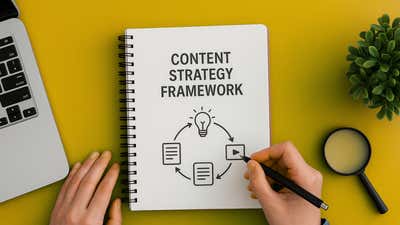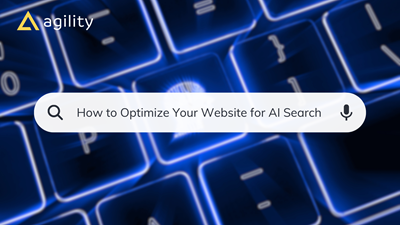Content Strategy Framework: A Modern Guide for 2025
Tips on making your content impactful and effective


The rules of content strategy are being rewritten – repeatedly and in real time – in 2025.
Content is no longer just about creating blog posts and social updates. It’s about developing contextual, intelligent, and adaptive experiences that meet users exactly where they are. The sweet spot of it all is serving content to users before they even know what they need.
As artificial intelligence becomes more embedded in search engines, personalization tactics, and content creation workflows, content teams must evolve from storytellers to orchestrators: Producing the right content, in the right format, with the right context, at the right moment, to the right audience.
The Pillars of a Ready-for-2025 (and Beyond) Content Strategy Framework
Blogs. Emails. Videos. Infographics. AI. Whatever makes up your content strategy framework (and ideally it should be all of those and more), it must cover the following pillars:
Purpose and Business Alignment
Every piece of content should support a clear and defined business objective. Awareness. Conversion. Retention. Thought leadership. Unsure what to write? Focus on what the business is looking to accomplish:
- What are the business goals for the quarter and/or year?
- How does content help achieve these goals?
- What measurable outcomes will validate that the content helped us reach the business goals?
AI: Audience Intelligence
Understanding your audience goes beyond demographics and target personas. Look at behavior – and how it changes over time – to not only define who you’re talking to but how they act. This can include things like:
- Qualitative data (interviews and surveys).
- Quantitative data (website behavior, A/B tests).
- Real-time, in-their-own-words feedback via feedback loops.
Content Differentiation and Brand Narrative
This is the tricky one. How to ensure your voice stands out in an oversaturated market where everybody can (sort of) say the same thing? In this instance, it’s not about catchy phrases or clever wordplay, but rather:
- Having a consistent tone across channels.
- Defining clear brand archetypes. Does your customer want to be the hero, the caregiver, the solver, or the creator?
- A master brand story that can be told in 118 seconds (average length of an elevator ride in NYC) or 1,600 words (average blog length on the Internet).
Here’s an example: Your Brand helps Your Audience overcome Their Problems so they can Achieve Desired Results.
Content Framework Strategy 2025: Content Types and Formats
In 2005, 56% of people had no knowledge of “weblogs” and 32% were familiar with them. Today, 83% of people read blogs daily. Meanwhile, 92% of users can access video content in 2025.
Audiences are consuming content in more formats than ever, and your content framework needs to be reflective as such and include the following:
- Modular Content: Break large assets into smaller parts (e.g. a long-form webinar into short, digestible clips into quote graphics into a blog summary).
- Interactive Content: Quizzes, ROI calculators, polls, product recommenders.
- Short-Form Video: Ideal for the TikTok, YouTube Shorts, and LinkedIn clips generation.
Generative AI is a tremendous tool to accelerate drafts and repurpose existing content. But it is not infallible. Always apply editorial insight – a sanity check – to any content generated by AI.
SEO Isn’t What It Used to Be
Every search engine has an AI overview, it seems. Which means SEO is no longer just about keywords. If customers can’t find you, they can’t buy from you. Your framework should include:
- Topic Clusters and Semantic Relevance: Create an umbrella page on a broad topic and link it to more focused cluster content.
- Search Intent: Why a user is searching is equally important as what they’re looking for.
- Fresh Content: A stale website is a lonely website. Ensure fresh content is produced regularly.
- Voice Search: Around 20% of people use voice search. As that number grows, focus on ranking for conversational, long-tail queries.
We are now in the zero-click world where users want value without having to click for it. Leverage AI SEO to build trust, visibility, and credibility.
Workflows and Governance
A robust content strategy framework doesn’t execute itself. It needs triggers, mechanisms, and stewards to ensure the right thing happens at the right time. That means:
Workflow Automation
- Use AI to assist with mapping content output to the brief, and to ensure editing and editorial standards are met.
- Automate version control and prevent stakeholders and approvers from reviewing irrelevant or outdated content.
Governance and Guidelines
- Establish clear editorial standards.
- Train AI to understand and check for accessibility and DEI compliance in accordance with your editorial standards.
- Define sunset policies to retire, repurpose, or remove legacy content that is no longer purposeful or valuable.
AI + Human Teamwork
- It’s easy (and tempting) to jump to AI for everything. It’s smarter to define when to use AI for ideation versus creation.
- Assign content gatekeepers to provide human accountability – a sanity check – over AI-generated content.
Content Strategy Framework Metrics to Measure in 2025
There’s no point in doing all this if you’re not measuring impact. Vanity metrics such as page views for your website or open rates for emails don’t paint the full picture. Instead, measure actionable or outcome-oriented metrics such as:
- Engagement Quality: Are users scrolling deep on your pages? On social media, are they leaving qualitative comments you can act upon? Who’s coming back for more of your content, and when?
- Content Health: Is fresh content being produced regularly? Is legacy content still accurate and relevant? Is your bounce rate high? Are there broken links pointing to or from your content?
- ROI Tracking: What is the content cost per lead or customer? Did your content touch a closed-won deal or drive upsells? How does content performance compare across initiatives?
When your metrics tell a complete story, you can further align content strategy with broader business goals, whether that’s accelerating pipelines, deepening customer loyalty, or optimizing marketing spend.
Don’t Forget Distribution
Content without distribution is just noise. Build a clear delivery plan across:
- Owned Channels: Website, email, blog, app.
- Earned Channels: SEO, social sharing, PR.
- Paid Channels: Social ads, sponsorships, syndication.
- Internal Channels: Sales enablement, customer success tools.
Your Content Strategy Framework is a Living System
A content strategy framework in 2025 is not a static, set-it-and-forget-it plan. It’s a living, evolving system driven by data and fueled by people, and supplemented with AI.
By implementing a modern framework such as this, content teams can ensure they stay agile and aligned with ever-changing business goals.

About the Author
Jina is the President of Agility CMS. She has over 20 years of marketing, leadership, customer success, and partnership experience within the tech space. She lives north of Toronto with her husband and three daughters.



